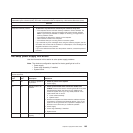
POST (ISPR) error procedures
Use the ISPR error procedures to help you solve ServeRAID problems. A complete
list of error codes is listed at “ServeRAID error codes” on page 105.
Note: Where the ISPR error procedures refer to a SCSI backplane, see the
chapter of this publication that concerns service replaceable units.
EF10 (Default ISPR)
1. No ISPR error present.
9Zxx through BZxx (SCSI bus error caused by cables, termination, defective
drives, or similar problem)
1. Isolate between SCSI subsystem and controller by disconnecting all SCSI
cables from suspect card, and restart.
Attention: Do not press F5. Doing so changes the computer configuration.
If an ISPR error is still present, perform the following actions until the error is no
longer present:
a. Reseat the controller
b. Replace the controller
Notes:
a. SCSI channel cable details, if any, appear elsewhere in this publication.
b. The adapter/controller detects a configuration change. Do not select Save
Changes. Instead, press F10 to bypass any options to this effect.
2. If ISPR error is EF10 after disconnecting cables:
a. Identify which channel is causing the error by the second digit (Z) of the
original ISPR code as indicated in the following table.
Note: ServeRAID-4H controllers have 4 channels; ServeRAID-4L and -4Lx
controllers have only one channel; and ServeRAID-4M and -4Mx
controllers have 2 channels. ServeRAID-5i and ServeRAID-6i
controllers have no channels. The ServeRAID-5i and ServeRAID-6i
use the channel connectors of the onboard integrated SCSI
controller.
Table 4. SCSI identifier
SCSI Channel Code (z) Descriptions
1 Channel 1
2 Channel 2
3 Channel 1 and 2
4 Channel 3
5 Channel 1 and 3
6 Channel 2 and 3
7 Channel 1, 2, and 3
8 Channel 4
9 Channel 1 and 4
A Channel 2 and 4
B Channel 1, 2, and 4
C Channel 3 and 4
Chapter 6. Symptom-to-FRU index 107


















